Meet the Presenters
This article is based on a webinar presented by STLE Education on Nov. 2, 2023. High-Performance Base Stock Technology for Automotive and Industrial Greases is available at www.stle.org: $39 for STLE members, $59 for all others.
STLE member Dr. Najeeb Kuzhiyil is currently the customer application development advisor for synthetic base stocks at ExxonMobil Technology and Engineering Co., USA. He has over 20 years of experience in the oil and automotive industries. An expert in fuels, lubricants and engine combustion, he has a doctorate degree in bio-renewable resources from Iowa State University and a master’s degree in combustion and energy from the University of Leeds (UK), where he was a Shell Centenary-British Chevening Scholar. He authored a book, “Spirit of Engineering,” that explains the basics of engineering through a story. He has published his scientific research in many prestigious journals and holds many U.S. patents. He lives in Houston, Texas.
Luca Salvi joined the grease product development team at the ExxonMobil Chemical Co. in July 2020, and he works on commercializing high-performance synthetic grease and lubricants. From 2012 until the summer of 2020, he worked as a researcher and formulator at the ExxonMobil Research and Engineering Co. developing the next generation of engine oils for passenger cars. He has a doctorate degree in chemistry, specializing in organometallic catalysis, from University of Pennsylvania, and he has worked at M.I.T. as a postdoctoral associate studying Pd-catalyzed cross-coupling reactions.
You can reach Kuzhiyil at najeeb.m.kuzhiyil@exxonmobil.com and Salvi at luca.salvi@exxonmobil.com.

Dr. Najeeb Kuzhiyil

Luca Salvi
KEY CONCEPTS
•
Synthetic base stocks are claiming a rapidly increasing share of the market for next-generation lubricants.
•
Polyalphaolefins made using metallocene catalysis excel as lubricant base stocks for low-temperature applications.
•
Long-lasting low-viscosity low-volatility PAOs perform well at high temperatures and motor speeds.
New technologies, including hybrid electric and fully electric vehicles (EVs) and offshore wind turbines, are designed to support the reduction of carbon emissions and fossil fuels. These and other high-demand applications are excellent examples of where next-generation lubricants built on new base stock compositions can provide benefits over the alternatives.
EV bearing greases, for example, must function effectively at high speeds and high temperatures in the presence of electric currents. Fill-for-life designs demand greases that can reduce friction and increase energy efficiency over longer time periods than ever before. Novel low-viscosity base stock formulations can maintain low volatility, offering longer life, and high-viscosity base stocks can offer superior low- and high-temperature performance.
Here, we discuss key attributes of high-performance base stocks that grease manufacturers can use for next-generation products to serve emerging and demanding industrial and automotive applications.
This article is based on an STLE webinar titled High-Performance Base stock Technology for Automotive and Industrial Greases presented by STLE member Dr. Najeeb Kuzhiyil and Luca Salvi. See Meet the Presenter for more information.
Looking forward, looking back
Today’s industries must keep pace with increasing worldwide energy demand and at the same time customers and regulators are demanding reduced costs and emissions. Achieving both these factors can be challenging, but they can also offer opportunities for manufacturers of high-performance greases. Long-term trends in grease applications are helping to drive innovative formulations that can provide longer service life while performing under more severe operating conditions. Improved durability can reduce the amount of grease used over the life of the bearing.
Base stock selection is critical to define lubricant properties in grease applications. Although users may be tempted to focus mainly on the type of grease thickener and to think of grease as a semi-solid, Kuzhiyil says, about 90% of a grease formulation is the base oil. Synthetic base stocks have better high- and low-temperature properties than mineral oils, he continues, and finished synthetic-based greases can reduce the coefficient of friction by about half over a wide range of entrainment speeds
(see Figure 1).
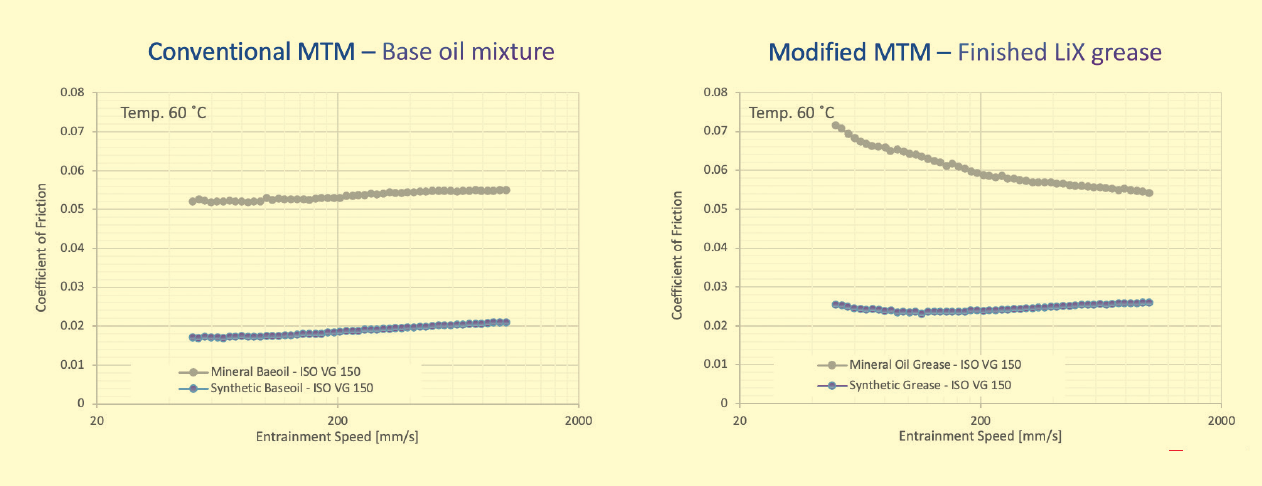
Figure 1. Synthetic oils have lower coefficients of friction than mineral oils across a range of entrainment speeds. (Left) base oil mixtures (150 cSt at 40°C); (right) finished lithium greases (ISO VG 150). MTM is mini-traction machine. Figure courtesy of W. Tian, ExxonMobil.
These advantages have driven a rapid increase in the use of synthetic base stocks. In the decade from 2012 to 2021, conventional greases went from a market share of 93% to 87%, according to NLGI annual production surveys from 2012 to 2021.
1 Synthetic grease market share went from 4% to 7%, semisynthetic greases went from 3% to 5% and biobased greases went from 0% to 1% during that same period. Production of synthetic greases went from 38 kilotons in 2012 to 65 kilotons in 2021, a compound annual growth rate (CAGR) of 6%. In contrast, total grease production remained almost flat (0.2% CAGR) over this period.
Many next-generation grease formulations use polyalphaolefins (PAOs) as base stocks. These saturated hydrocarbons, typically derived from linear alpha olefins (LAOs), have been produced synthetically for almost 60 years. (Biobased PAOs, derived from plant sources, are a recent innovation.) In 1877, Charles Friedel and James Crafts developed a method to attach substituents to aromatic ring compounds using the reaction that now bears their names. This method of functionalizing aromatic rings relies on a strong Lewis acid catalyst like aluminum chloride to activate the substituent molecules. The method often produces products that are more reactive than the starting materials, leading to further reactions that form polyalkylated products. Although polyalkylation can be a drawback in certain applications, it is useful in making oligomers from alpha olefins to produce PAOs having a wide range of viscosities.
Acid-catalyzed polymerization took off in the 1930s, and the first patent for making PAO oils from LAOs using an acid catalyst was issued in 1951 (U.S. Patent 2,559,984). Acid catalysts were used to manufacture PAOs beginning in the late 1960s, with the first commercial PAO-based passenger vehicle lubricants appearing in the early 1970s. In the 1990s, the first patent was issued for mPAOs, polyalphaolefins made using metallocene catalysts (U.S. Patent 5,324,800A). A high-viscosity mPAO product line was launched in 2010
2 and a low-viscosity low-volatility PAO (LVLV PAO) followed in 2021.
3
Comb-like mPAOs excel in the cold
Low-temperature applications demand lubricants that are up to the job. For example, they must maintain an optimal viscosity over their range of operating temperatures so as not to increase traction or cause problems with lubricant flow. One such application, offshore wind turbines that operate at high latitudes far from shore, high above the ocean’s surface, are difficult to access, and maintenance and repairs are complex and costly. To help enable the extended lubricant drain intervals needed for efficient operations, base stocks for oils and greases must provide excellent stability against oxidation and outstanding low-temperature fluidity.
Metallocene catalysis can produce high-viscosity PAO base stocks with molecular structures that can provide these critical performance attributes. Integrating metallocene catalysis into PAO manufacturing has enabled molecular structure improvements that significantly improved the lubrication performance of high-viscosity PAO-based greases. This improvement is a direct result of the molecular structures of the resulting mPAOs compared with conventional PAOs and mineral oils
(see Figure 2).
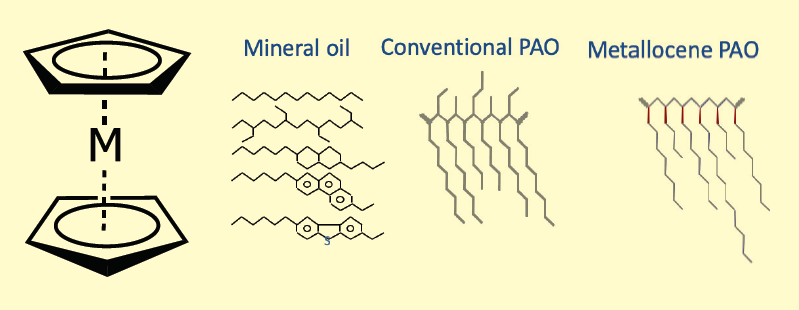 Figure 2. (Left) Metallocene catalysts consist of aromatic cyclopentadiene rings complexed with a metal atom. (Right) Mineral oils consist of a mixture of several types of hydrocarbons; conventional PAOs have a more uniform composition, but side chains are attached to the backbone at different angles; mPAO side chains are attached at the same angle. Figure 2a courtesy of Innerstream, Wikimedia Commons, public domain. Figure 2b courtesy of ExxonMobil.
Figure 2. (Left) Metallocene catalysts consist of aromatic cyclopentadiene rings complexed with a metal atom. (Right) Mineral oils consist of a mixture of several types of hydrocarbons; conventional PAOs have a more uniform composition, but side chains are attached to the backbone at different angles; mPAO side chains are attached at the same angle. Figure 2a courtesy of Innerstream, Wikimedia Commons, public domain. Figure 2b courtesy of ExxonMobil.
Mineral oils are a mixture of hydrocarbons: aliphatic, aromatic, branched, straight-chain, naphthenes and polycyclic aromatics. The variety of molecular structures in the mixture affects the way they pack together to form a lubricant film. The low packing efficiency, in turn, affects the ability of the grease to form an effective tribolayer, the grease’s low- and high-temperature properties and its traction coefficient. Conventional PAOs, made using an acid catalyst process, contain molecules with a more uniform composition than their mineral oil counterparts.
4 However, these PAO molecules are highly branched hydrocarbons with chains extending in all directions from the molecular backbone, “like a bottle brush,” says Kuzhiyil. In contrast, he says, PAOs made using metallocene catalysts (mPAOs) are more like a flat comb. These molecules are also highly branched, but the chains extend from the backbone in one direction; that is, the molecules are isotactic.
This structural uniformity provides greases with better low-temperature performance and oxidative stability and lower traction. Greases made with isotactic mPAOs have high-viscosity indices (VI)—as high as 220, compared with conventional mineral oils (95 to 100) and highly refined mineral oils (about 120). A higher VI means that the grease maintains a better film thickness at high temperatures while not over-thickening (keeping a lower viscosity) at low temperatures
(see Figure 3).
 Figure 3. Base stock comparisons for (left) oils in API Groups I and II+, conventional PAO and mPAO and (right) conventional PAOs (cPAO) and metallocene PAOs (mPAO). Figure courtesy of ExxonMobil.
Figure 3. Base stock comparisons for (left) oils in API Groups I and II+, conventional PAO and mPAO and (right) conventional PAOs (cPAO) and metallocene PAOs (mPAO). Figure courtesy of ExxonMobil.
Low-temperature performance is critical for mining operations and wind turbines (offshore and land-based) in cold climates. These applications demand high-viscosity greases that can stand up under heavy loads and slow rotational speeds, which can reduce potential damage to the bearings and greases, and at the same time not cause excessive viscous drag that could increase energy usage. Typical high-viscosity industrial grease formulations, which combine a synthetic base stock with a solubilizing co-base stock, have kinematic viscosities ranging from 100 to 460 centistokes (cSt).
One series of tests used an mPAO base stock under conditions simulating low-temperature mining operations. A 460 cSt grease made with a 300 cSt mPAO and an alkylated naphthalene (AN) co-base stock demonstrated a significantly better ability to flow at -20°C than either its mineral oil counterpart or a conventional 100 cSt PAO. At -40°C, the mPAO grease reduced the low-temperature starting torque significantly better than either the mineral oil grease or the conventional PAO grease
(see Figure 4).
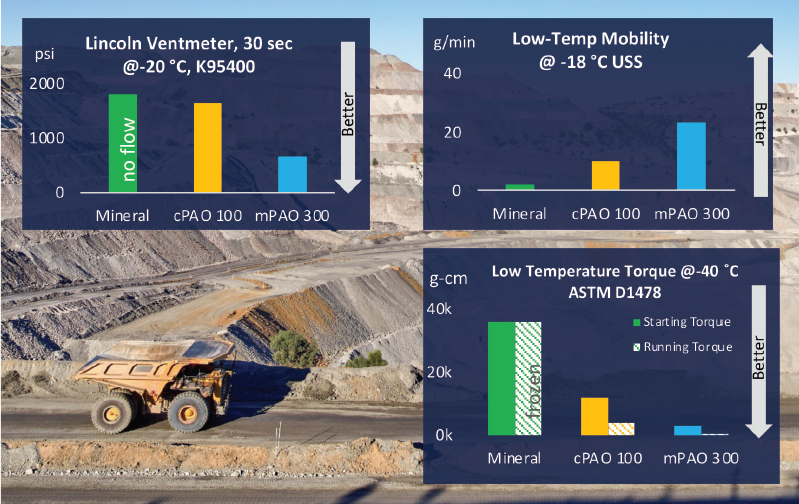 Figure 4. Comparison of low-temperature ventability, mobility and torque for greases based on mineral oil, cPAO and mPAO formulations (base plus AN with calcium sulfonate thickener, 460 cSt) at temperatures typical of Arctic mining operations. Figure courtesy of Axel Christiernsson and ExxonMobil.
Figure 4. Comparison of low-temperature ventability, mobility and torque for greases based on mineral oil, cPAO and mPAO formulations (base plus AN with calcium sulfonate thickener, 460 cSt) at temperatures typical of Arctic mining operations. Figure courtesy of Axel Christiernsson and ExxonMobil.
Low-temperature starting torque is also important for wind turbines, with blades that start and stop with the wind conditions. If the torque is too high as the blades are starting to move, they may need assistance to start rotation, which can result in loss of energy production. Tests comparing 460 cSt greases based on a 150 cSt mPAO, the same mPAO with an AN, and a mineral oil showed that both of the mPAO greases outperformed the mineral oil grease with regard to shear and oxidative stability, as well as cold flow pumpability. The AN slightly worsened the pumpability of the mPAO grease, but it further improved the oxidative stability over the mPAO alone
(see Figure 5).

Figure 5. Comparison of low-temperature shear stability, oxidative stability and cold flow for greases based on mineral oil, mPAO and mPAO+AN formulations (lithium soap thickener, 460 cSt) at conditions typical of high-latitude wind turbine operations. Figure courtesy of ExxonMobil and Afton Chemical.
Low-viscosity synthetic base stocks
Heavy machinery and low-temperature applications are large end uses in the high-viscosity lubricant market, but the passenger vehicle market is a main driver in the development of low-viscosity lubricant fluids and greases. Although both the internal combustion engine (ICE) vehicle and EV markets are working to increase energy efficiency and lower CO
2 emissions, they are going about it in different ways.
Despite a recent increase in EV production, one projection predicts that even in 2050, almost half of all light-duty vehicles (including hybrid ICE/EVs) will have ICEs.
5 The ICE market focus is dominated by fuel economy and reducing emissions, as well as the use of highly standardized lubricant formulations. Meanwhile, EV market focus is more on extending range, and vehicle manufacturers each have their own hardware and lubricant specifications and requirements. Both of these approaches present challenges and opportunities for lubricant formulators, and low-viscosity lubricants can support both types of engine platforms in pursuit of their goals.
The 0W-20 lubricants currently on the market have been shown to reduce drag, which can improve fuel efficiency,
6 but lubricants with even lower viscosities are emerging. Some high-end passenger vehicles use 0W-12 oil in their hybrid models, which have engines that frequently start and stop during in-town driving. Some Japanese car makers specify 0W-8 engine oils for their hybrid and plug-in hybrid EVs).
7
EVs, in particular, demand next-generation fluids that can help retain their lubricating and thermal management properties and resist oxidation under high-speed, high-temperature operating conditions. These fluids must also be electrically insulating enough to help prevent arcing and stray currents, while conducting just enough electricity to prevent a buildup of static charge.
Electrical conductivity optimization is also important for grease applications, as EV bearings can be exposed to voltages in the neighborhood of 20,000 volts. A grease that is not sufficiently insulating can fail to prevent arcing, which can burn the grease and can damage the bearings. Next-generation greases can use the base stock as a starting point and tune the conductivity using co-base stocks and additives. The best conductivity range depends on the application and the make of vehicle, although increasing standardization as the EV market matures may make this range more uniform across various makes and models.
Further, EV fluids must be compatible with any seals, insulation, copper windings and other materials that they come into contact with—and some of these materials have only recently been introduced to automotive applications. A trend toward fill-for-life fluids and greases demands that they continue to perform effectively with minimal degradation for as long as possible, and the small amounts of lubricant used in EVs can increase the performance requirements still further.
Various EV systems demand different things from a lubricant base oil. Electric motors call for lubricants designed for energy efficiency (and increased driving range), wear protection, heat transfer and cooling ability (some EVs use the same fluid for lubrication and for cooling), thermal stability, optimal conductivity and material compatibility. Gearbox oils are designed to help protect against wear, improve energy efficiency and remain stable against oxidation. Fluids for batteries and electronic components serve for thermal management and to support safe operation, as well as providing insulation, and these fluids must also be compatible with the materials with which they come into contact. Many major OEMs use an integrated e-module that comprises the drivetrain, motor and electronics. A single fluid is used in such e-modules, which can place even higher demands on the lubricant.
One promising development in synthetic base stocks is a line of low-viscosity low-volatility PAOs (LVLV PAOs). This class of base stocks helps address one problem that has plagued oils in Groups I, II and III: namely, as their viscosity decreases, their volatility increases exponentially. Although the same is true for LVLV PAOs, these oils are significantly less volatile across a range of kinematic viscosity values
(see Figure 6).
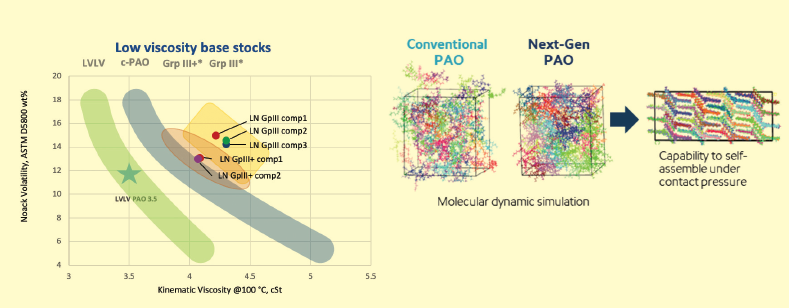 Figure 6. (Left): Lubricant base stocks become more volatile at lower viscosities, but this effect is less pronounced for LVLV PAOs (green) than for mineral oil base stocks (yellow: Group III; orange: Group III+) or conventional PAOs (blue). (Right) Next-generation PAOs have fewer different molecular isomers than conventional PAOs (colors represent various isomeric configurations), enabling them to form more stable tribolayers under pressure. Figure courtesy of ExxonMobil and publicly available data from KV100 and NOACK.
Figure 6. (Left): Lubricant base stocks become more volatile at lower viscosities, but this effect is less pronounced for LVLV PAOs (green) than for mineral oil base stocks (yellow: Group III; orange: Group III+) or conventional PAOs (blue). (Right) Next-generation PAOs have fewer different molecular isomers than conventional PAOs (colors represent various isomeric configurations), enabling them to form more stable tribolayers under pressure. Figure courtesy of ExxonMobil and publicly available data from KV100 and NOACK.
Here again, the molecular structures of next-gen PAOs provide a basis for their performance as base stocks for lubricating oils and greases, according to Kuzhiyil and his colleagues’ test data. Conventional PAOs have a narrower distribution of molecular weights than their mineral oil counterparts, but they still exhibit a high degree of isomerization. LVLV PAOs have significantly less isomerization, resulting in a flatter molecular alignment in the tribofilm. The increased ability of the LVLV PAO molecules to slide over each other within the fluid film reduces traction for better lubricity. (LVLV PAOs produce films with essentially the same thickness under pressure as for other synthetic base oils with similar viscosities.)
At 40℃, mini-traction machine (MTM) tests show that a 3.5 cSt LVLV PAO performs slightly better than a conventional PAO blend and significantly better than a blend of Groups II+ and III oils. Comparing the performance of a 3.5 cSt LVLV PAO with a conventional PAO, Group III and Group III+ oils shows that the LVLV PAO performs as well as or better than the other oils with regards to flash point, volatility, thermal properties, foam resistance, elastomer compatibility and electrical properties
(see Figure 7).
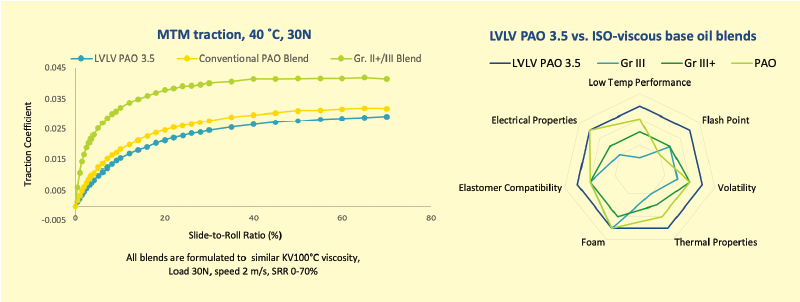 Figure 7. LVLV PAOs exhibit superior traction reduction and low-temperature performance compared with Group III and III+ oils and conventional PAOs. Figure courtesy of ExxonMobil.
Figure 7. LVLV PAOs exhibit superior traction reduction and low-temperature performance compared with Group III and III+ oils and conventional PAOs. Figure courtesy of ExxonMobil.
In real-world situations, EVs are running at high temperatures, and their lubricants exhibit various degrees of aging. How well do LVLV PAO greases hold up compared with other base stocks? In a test comparing a neat 3.5 cSt LVLV PAO base stock with neat Group III and Group III+ base stocks, all three exhibited very low conductivity between 20℃ and 170℃ when they were fresh. These base stocks were then laboratory-aged (CEC L-48 method, 192 hours at 170℃). As the temperature rose above 80℃, the electrical conductivity of the Group III and Group III+ base stocks began to rise rapidly, indicating that they had begun to oxidize. The LVLV PAO conductivity also rose, but more slowly and to a much lesser extent, according to Kuzhiyil and his colleagues’ test data.
An energy consumption comparison of 32 cSt greases using various base stocks and a soap thickener (not full formulations) used a special high-speed bearing test rig to measure traction reduction at room temperature over an extended period of time, according to Kuzhiyil and his colleagues’ test data. Each of the base stocks was formulated into a 30 cSt grease with a polyurea thickener. A Group III formulation was used as the baseline. A conventional PAO grease (PAO 6) reduced energy consumption by 1%, while a blend of 3.5 cSt LVLV PAO and mPAO 300 reduced it by 3%. A blend of 3.5 cSt LVLV PAO and an alkylated naphthalene (AN 12) produced a 12% drop in energy consumption
(see Figure 8).
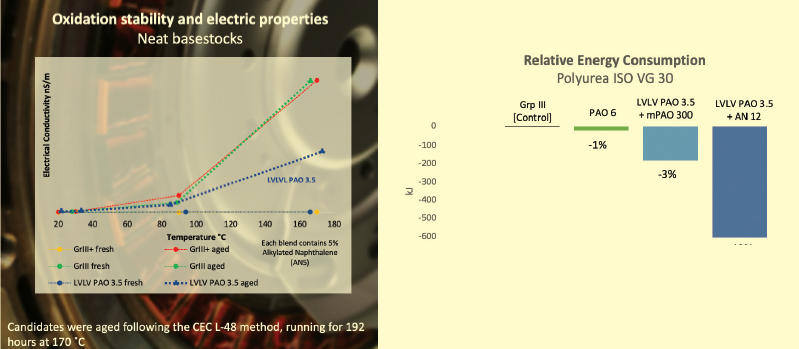
Figure 8. (Left) Increases in electrical conductivity at elevated temperatures indicate that these laboratory-aged oils are oxidizing, but LVLV PAO is more stable against oxidation. (Right) Tests performed at room temperature on a high-speed bearing test rig show that LVLV PAO reduces energy consumption compared with similar grease formulations using different base oils. Figure courtesy of (left) ExxonMobil and (right) KTH Stockholm.
Next-gen base stocks for new applications
Recent growth in synthetic-based greases has increased at a significantly higher rate than that of the overall grease market, driven largely by increasing demands for performance over a long service life under demanding conditions, increased energy efficiency, reduced lubricant usage and emission reductions.
1 High-performance synthetic base stocks, including PAOs, provide a significant lever to improve finished grease performance across different additive and thickener systems, Kuzhiyil says. The development of LVLV PAOs with reduced isomerization have resulted in base stocks that meet or exceed mineral oil, Group III and III+, and conventional PAO base stocks over a variety of performance metrics, according to Kuzhiyil and his colleagues’ test data.
REFERENCES
1.
www.nlgi.org/grease-production-survey/
2.
www.fuelsandlubes.com/flo-article/exxonmobil-chemical-adds-65-cst-grage-to-spectrasyn-elite-mpao-portfolio-2/
3.
www.fuelsandlubes.com/exxonmobil-chemical-introduces-next-generation-pao-base-stock/
4.
Rudnick, L.R. (2013), Synthetics, Mineral Oils and Bio-Based Lubricants Chemistry and Technology, New York: CRC Press, p. 312.
5.
ExxonMobil Energy Outlook 2025,
https://corporate.exxonmobil.com/sustainability-and-reports/global-outlook
6.
https://garage.eneos.us/news/behind-the-rise-of-0w-20/
7.
www.underhoodservice.com/what-you-need-to-know-about-low-viscosity-oils/
Nancy McGuire is a freelance writer based in Albuquerque, N.M. You can contact her at nmcguire@wordchemist.com.